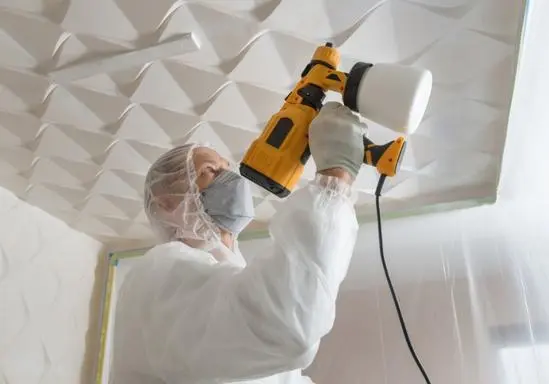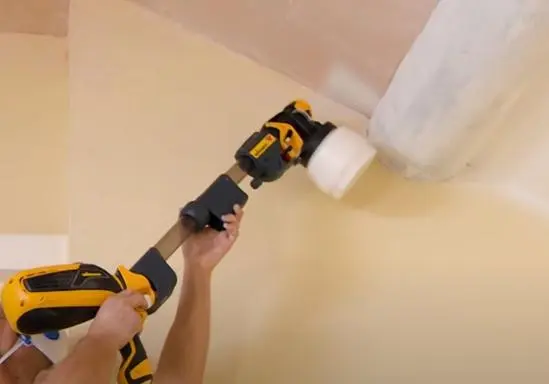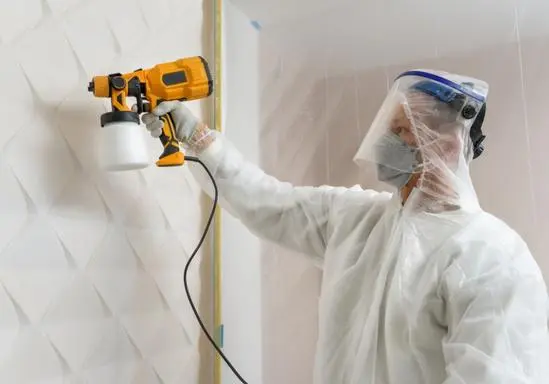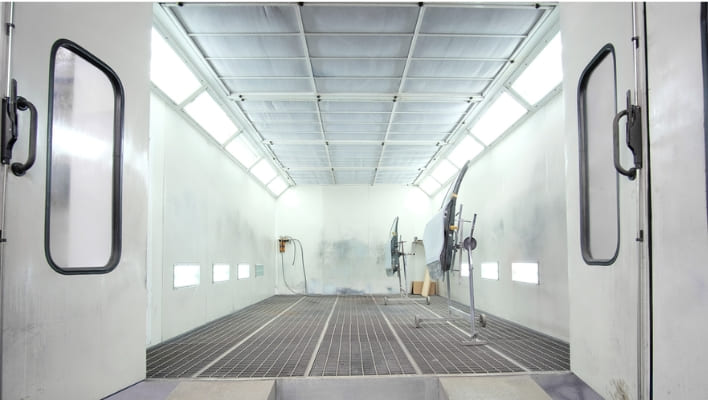Spray paint ceilings are one of the best and quickest ways to get the painting job done. Nevertheless, it’s not a piece of cake as everyone thinks, and you need to learn how to paint a ceiling with a sprayer.
Sprayers come in different models, sizes, shapes, and, most importantly, the working phenomenon. Unlike ordinary sprayers, airless paint sprayers are usually common due to their all-in-all benefits. Regardless of the type, you should know the accurate procedure to paint a ceiling using a sprayer.

Table of Contents
- Spray Painting Ceilings – Step-by-step Guide
- Step 1: Preparation
- Step 2: Choose the Best type of Paint Sprayer for ceilings
- Step 3: Set up The Paint Sprayer
- Step 4: Adjust The Sprayer’s Pressure
- Step 5: Start Spraying Ceiling Paint
- Step 6: Clean The Paint Sprayer
- Can You Spray Paint A Ceiling?
- Best Tips for spraying ceiling paint
- How To Spray Paint Walls?
- Spray Paint Ceiling Or Walls First
- Interior Painting Spray
- Spray Painting Ceiling Fan
- Spray Painting Ceiling Tiles
- FAQs On How To Paint A Ceiling With A Sprayer?
- Can you use a sprayer to paint ceiling?
- Is it better to spray or roll a ceiling?
- What is the best tip for spraying ceilings?
- Can you use an electric paint sprayer to paint a ceiling?
- What is the easiest way to paint a ceiling?
- How many coats of paint does a ceiling need?
- Bottom Line On Spray paint ceilings
Spray Painting Ceilings – Step-by-step Guide
Painting a ceiling with a sprayer is incredibly challenging if you don’t follow the right procedure. You must get the accurate paint finish, save yourself from paint, and prevent overspray. All this is possible using a sprayer. Let’s discuss the step-by-step procedure to spray painting walls and ceilings in the following:
Step 1: Preparation
First, you need to prepare the surface you want to paint. For it, start by cleaning the surface properly and sanding if necessary. If you have done cleaning, the next step is to apply a mask. A mask helps you get the even and spotless paint finish. Not only this, but cover the areas, windows, and ventilation with a paper or fleece.
Cover floors and furniture, use paint spray shield or painter’s tape to protect walls, hold sprayer steady, apply thin coats for even coverage. Also, take proper care while covering the walls with different care, i.e., the edges should be covered properly.
Step 2: Choose the Best type of Paint Sprayer for ceilings

After that, select the sprayer according to your ceiling project type. First, analyze your ceiling paint project, list the requirements, and finalize a sprayer type. You can go for HVLP, LVLP, and other sprayer types. However, the commonly used paint sprayer for ceilings is airless paint sprayers and electric paint sprayers.
Step 3: Set up The Paint Sprayer
After selection, it’s time to set up the paint sprayer. The best and easiest way is to read the included manual, or you can take the instructions from any paint store. You must select the sprayer accessories carefully, such as nozzle, nozzle extension, long-reach gun, and more. Different kinds of accessories are available for specific painting projects; you can select them based on the size or height of the home.
Step 4: Adjust The Sprayer’s Pressure
Remember that sprayers work with a certain pressure, whether produced by air or a motor. You must adjust the sprayer’s pressure according to the height and standing position. Again, you can get help from the manufacturer’s manual. If you want to test the pressure, spraying on a piece of cardboard is a good choice.
Step 5: Start Spraying Ceiling Paint

Now, start applying the paint all over the ceiling using the same method you use for the walls. Don’t forget to keep going at the same angle and distance from the ceiling. You should apply the paint at a constant speed to get an accurate finish. In case you are working on a big project and want to take a short break, cover the paint container with the lid. Otherwise, it may dry out.
Step 6: Clean The Paint Sprayer
A paint sprayer always requires proper cleaning after a painting project to make it usable again. For it, detach the holder and nozzle and leftover all the material using water. It’s better to clean it in a bucket of water. Thoroughly clean it with a water solution if needed. If you have a budget, you can use specialized cleaning tools such as nozzle cleaner, etc.
Can You Spray Paint A Ceiling?
Yes, you can definitely paint a ceiling with sprayer. During the process of painting ceilings, I learned a lot. Therefore, I’m sharing my experience with you so that you can learn from it as well.
I remember, I bought a Wagner FLEXIO 590 handheld sprayer and Emulsion Paint for Walls and ceilings painting.
You might wonder: Will this Wagner sprayer work with emulsions or do you have to dilute the paint first?
If this query is hopping in your mind, then let me tell you:
You can use a Wagner sprayer with all emulsions, but I recommend diluting it with warm water by 5-10%, particularly for water-based paints and testing it first on cardboard. Additionally, it is better to strain the paint through a sieve before diluting it with warm paint. In this way, you will achieve fine atomization with no paint blocking or spitting!
The Wagner paint sprayer comes with two reservoirs, so you can paint indoors or outdoors, with any paint brand, or color. You can use the large reservoir to paint the walls and ceilings, and even apply masonry paint for the exterior projects. Furthermore, there is a small reservoir that you will use for your metalwork and woodwork.
The most important thing you do before spraying paint inside your house is mask the surfaces you don’t want to paint. It’s easy to cover the walls with plastic sheets. Also, don’t forget to wear your safety goggles and respiratory mask before spraying.

I’d also suggest using an extension handle for your spray gun. It is really helpful to have a spray gun extension, especially when it comes to ceilings. It simply clips to the unit itself and gives you 600 millimeters more reach so you can paint the ceilings easily. Furthermore, extensions reduce overspray because more paint is sprayed onto the ceiling than into the air at a closer distance.

Once I attached the extension handle to the spray gun, I started painting the ceiling white in long, straight lines.
It’s advisable to paint the ceiling in a line pattern.
Working in a line pattern is the most effective way to achieve a smooth coat on the ceiling. If you want even coverage, overlap your subsequent strokes by about 50%.
I also applied a second coat when the first one dried. It can take 4-8 hours for the base coat to dry depending on the type of paint you have selected. Overall, Wagner 590 sprayer provides really nice, consistent finish over head.
Those of you who’ve painted walls with rollers know how physically difficult it is and how long it takes to do two or three coats after waiting for them to dry.
Hence, those days are gone! Spray paint technology is the future. It’s quicker and easier, but you need to practice with a paint sprayer before you start painting.
If you are a beginner but want a beautiful ceiling paint finish, we have a great idea for you. Check out the professionals and DIYers best spray tips for the ceiling to complete a painting project easily.
Best Tips for spraying ceiling paint
- First, prepare the surface on which you will apply the paint. Use the stripers to remove the old paint when the ceiling already consist of the paint.
- Choose the sprayer carefully after reading the instructions and also set it up.
- Prepare a particular amount of paint to apply to the ceiling. Ensure that you have enough paint to complete your spray paint project.
- You should maintain a distance between your spray gun and the surface. The recommended distance is 10-12 inches.
- If you want a good finish, grab the sprayer in a vertical direction.
- Examine the tip position to make sure that it hits even the small spots.
- Continuously check the spraying patterns.
- Don’t apply the thick coat; instead, try to apply two thin coats.
- You can also perform sanding between two coats depending on the surface.
- Clean the sprayer before starting if you are using an old paint sprayer.
These tips are very helpful for newbies who want to be professional painters. We have shared the necessary tips so that you can keep track of essential parameters to get the job done easily.
How To Spray Paint Walls?

It is a common fact that when you want to spray paint interior walls, the procedure is similar. However, the coverage areas will be different. You have to cover the windows and ventilations but also the ceiling. Again use the tape or masking film to cover the corners of the ceiling. It’s also better to place a masking film on the floor. For painting walls, apply the paint in a horizontal manner to reduce the over-spray.
Spray Paint Ceiling Or Walls First
Sprayers offer both functionalities to use for ceilings or walls. If you have decided to paint the whole bedroom, i.e., walls and ceiling, you can use a sprayer for it without any problem.
However, what to paint first: the ceiling or walls?
It is recommended by professionals that start by painting the walls before the ceiling. Also, it allows the walls to dry properly before painting the ceiling.
Interior Painting Spray
When you don’t want to compromise on the paint finish and complete it in a minimal time, a sprayer might be your vital choice. They also act as perfect tools for indoor painting, faster than other methods.
When choosing a sprayer for interior painting, make sure you take all the precautions and learn all the information.
Moreover, It would also be wise to watch a video that shows how to paint a ceiling faster with a sprayer before painting, as I did.
Spray Painting Ceiling Fan
Painting a ceiling fan is pretty easy while doing a ceiling paint project. First, turn OFF the electrical power supply and remove the fan blades. Clean the fan and blades with a water solution to remove dirt. Mask the ceiling above the fan to prevent over-spray. Start painting all over the fan. Further, paint the other parts of fan and attach them again with the fan when dry.
Spray Painting Ceiling Tiles
If you have some sort of tiles, you can spray paint them easily. We recommend you use a spray paint vessel for painting ceiling tiles. Just spray the tiles off in an even manner and make the corners properly with the paint. Apply more than one coats if you feel it necessary. Don’t forget to cover the stained areas as paint also acts as a sealer.
FAQs On How To Paint A Ceiling With A Sprayer?
Can you use a sprayer to paint ceiling?
Yes, paint sprayers are very helpful for painting all kinds of the ceiling. They require very less effort and also offer the best painting results. Whether it’s a bedroom’s ceiling or home, paint sprayers are highly recommended.
Is it better to spray or roll a ceiling?
Rollers are suggested for smaller projects, and many professionals use them for ceiling paint. However, you don’t get enough top-notch results. Sprayers are better for ceiling paint in terms of even finish and quick working.
What is the best tip for spraying ceilings?
Tips are available in different sizes, and they offer different painting results. For large ceiling paint projects, 411 spray tip is suggested. You can use lacquers or interior paint for application. If it is not suitable, you can go for 515 spray tips.
Can you use an electric paint sprayer to paint a ceiling?
Electric sprayers are one of the most affordable sprayers nowadays. They give broad functionality and are manufactured from high-quality material. Not only ceilings but they are also recommended for all kinds of projects, especially for the larger ceilings.
What is the easiest way to paint a ceiling?
When painting a room, paint sprayers are much better for high ceilings or textured ceilings. However, Helen Shaw at Benjamin Moore recommends using a brush for painting the edges of ceilings.
How many coats of paint does a ceiling need?
A single coat won’t provide even coverage and a flawless finish. Therefore, if you are painting a wall or ceiling, you should apply a minimum of two thin coats.
Bottom Line On Spray paint ceilings
In conclusion, the ceiling is the most prominent part of every home and needs to be painted perfectly. You can utilize different painting tools for ceilings, but the sprayer plays an ideal role. We have shared the easiest method on how to paint a ceiling with a sprayer and important tips for spray painting ceilings. Don’t forget to take safety precautions and read the instructions to get high efficiency for your project.

Jennifer Marie
Jennifer Marie is a general contractor with over the years of experience in home remodeling, DIY projects, and commercial painting projects. Her experience includes working with paint sprayers, painting tools, and other painting supplies. You can follow her on Facebook.


